Lasting Art
Jean Westmacott spent 16 years helping catapult Brenau University into a North Georgia oasis for painting, sculpture and other works in a region that a satirist once referred to as ‘The Sahara of the Bozarts.’ Her work in bronze, marble and other media now helps tell the Brenau story in a way that is destined to be around for a long, long time.
On a Friday morning at the two-story 1880s home in Oglethorpe County, the sculptor Jean Westmacott completes making the coffee cake for a visitor. She mixed ingredients without a recipe in sight, gradually blending in fresh pecans as she poured the batter into a pan. She prepared coffee in a French press before slicing pieces of cake for her and her visitor. Then, she settled onto a comfy sofa for along chat about the seemingly idyllic life of an artist in the woods east of Athens, Georgia.
Her husband, Richard, a retired University of Georgia landscape design professor, wandered through, taking a break from his daily overseeing of the 200-plus-acre farm. He showed off the newborn puppies of Phoebe, a rat terrier, nestled in a box in a downstairs bathroom. Kofi, a whippet, strolled by for a petting before settling on a nearby chair. Later Richard returned for a lunch of his homemade venison pâté, toast and a soup made with mushrooms picked nearby.
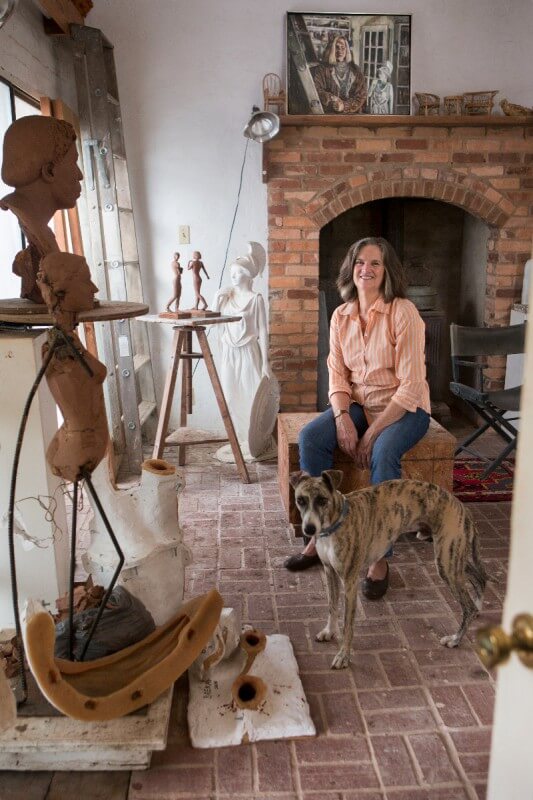
“I was a complete romantic. I had no idea of the work involved.” Westmacott said about buying the farmstead without a trace of irony.
Despite this early autumn setting that more bespeaks the image of a photo shoot for a Martha Stewart county living magazine, there is work – and plenty of it. In addition to normal maintenance chores typical of a place that large, Jean and Richard Westmacott have been moving from neighboring properties and restoring houses and other structures, most dating to 1800s. In addition to the main house, they also have a log house from the 1850s, a small house built in 1810, and a schoolhouse built in 1890 that are now located on their property, modernized and restored to use as rental houses. Nestled in the trees with blooming shrubbery and a rustic fence is Westmacott’s studio, a small building where she is deconstructing models of earlier projects and contemplating where her art will take her next. She repaired there after retiring in 2006 from Brenau University, where she was galleries director and an art professor for 16 years.
Westmacott refers to most of her sculpture as “portraits,” because they are “realistic representations of an individual.” The pieces also were generally cast in bronze, meant to last. The studio has maquettes, sketches and an unused clay model from arguably one of her most famous works, the statue of the goddess Athena that is the public art centerpiece for the namesake Georgia city. It is in the studio, too, that Westmacott completed her most recent commission for Brenau University – a pair of bronze statues depicting modern Brenau women.
But she is right about the romanticism, too. That romance recurs as a theme in her life and work along with a willingness to dive into unknown waters and no reluctance to persistently push through restrictions of business-as-usual tradition with limited resources. She brought those ideas to fruition as a bold and aggressive hand in the establishment of Brenau University as a regional powerhouse in the world of art during her tenure as Brenau galleries director from 1990 to 2006. She has now carried it forward with the works now displayed on campus that celebrate Brenau’s evolution as an institution and that accurately recognize its role in today’s world.
Surprisingly, she arrived at that point – as with much art – almost by accident. Or at least through a pinball-like bounce of serendipity.
Westmacott grew up in Pennside, near Reading, Pennsylvania, the only child of Hildegard and E. Spencer Wilkins. Her father, a draftsman, died in 1970 when she was just 23. Her mother, skilled in handwork, including knitting and crocheting, lived to 100, passing away in April 2011. She took some art courses along the way, but wioth her mother’s nudging her toward a career in teaching, after her first two years at Albright College in Reading, Westmacott transferred to Temple University in Philadelphia and earned her bachelor’s degree in psychology with a minor in art.
With her degree in hand, she took a full-time job at the place where she had worked part time since the summer before her senior year, job at Elwyn Institute, the prestigious school for children with profound developmental and emotional disabilities in the Main Line Philadelphia suburbs.
There she met a student named Kenny who became both the actual and metaphorical embodiment of the challenges she faced. She discovered that it was not enough to do the best she could with these kids; she had to go that extra mile to try to make sure they could achieve at as high a level as possible. Kenny could not speak, but he could read, and she discovered that he had the intelligence to achieve far beyond the limits of his diagnosis.
“He knocked my socks off,” she said, smiling at the memory. “The more I gave him to do, the better his behavior. I had a battle with the teacher for the ‘normal’ elementary class. She was set against his being moved up.”
During the early stages of her three-year tenure at Elwyn Westmacott considered that she might pursue a career as a child psychologist or art therapist. Although she did not say this explicitly, she inferred that her encounters with kids like Kenny and her frustrations at being unable to succeed for them, even after going the extra mile, proved to be a stressful and emotionally debilitating experience. She he began taking pottery classes as a way to cope with the stress of her job at Elwyn. She began seeing a therapist.
And that would be the next step – or sidestep – on her serendipitous journey.
All she had to do was show a little thigh.
POT LUCK
One of Westmacott’s pottery classmates was the late Bertha Rosenberg Blai. In early 1969, she was at a party with Blai when an elderly man with a thick Russian accent approached her and said to the shocked, taken-aback Westmacott, “I want those thighs.”
Blai hurriedly explained that the overly forward man was, in fact, her husband, Boris, who was the famed sculpture student of Auguste Rodin and who, after moving to the United States following his World War I service in the French army, founded the Tyler School of Art at Temple in 1935. So his interest in Westmacott’s thighs was, shall we say, purely academic.
Westmacott subsequently visited the Blais’ home often – driving over after work to have dinner with the older couple, do a little modeling for Boris and a little potting with Bertha. She actually lived with them in the summer of 1969. Both of them encouraged her to develop her drawing and sculpture talents. Boris particularly focused on the restorative powers of art. In 1943, during World War II, based on his own experiences as a soldier in the Great War, Blai started art classes for soldiers at Fort Dix, New Jersey. He believed before most how important the creative outlet is, and used this technique to help heal soldiers who were having various mental disorders from being at war.
Her therapist, Dr. Joseph O’Connor, also encouraged her art, asking her to bring work with her to some of their sessions. In fact, it was he who told her one August about a master’s degree-level art program that was to begin the next month at the University of Pennsylvania. Although she was missing some required undergraduate courses in print making, photography, three-dimensional design and drawing, and although it is not exactly easy to get into Ivy league graduate programs even with months and months of lead time, the therapist and the Blais encouraged her to apply anyhow.
Here’s the thing: with serendipity, you never know. Here’s what happened next: One of the students who had been admitted to the program dropped out. Westmacott got in.
WILL WORK FOR …
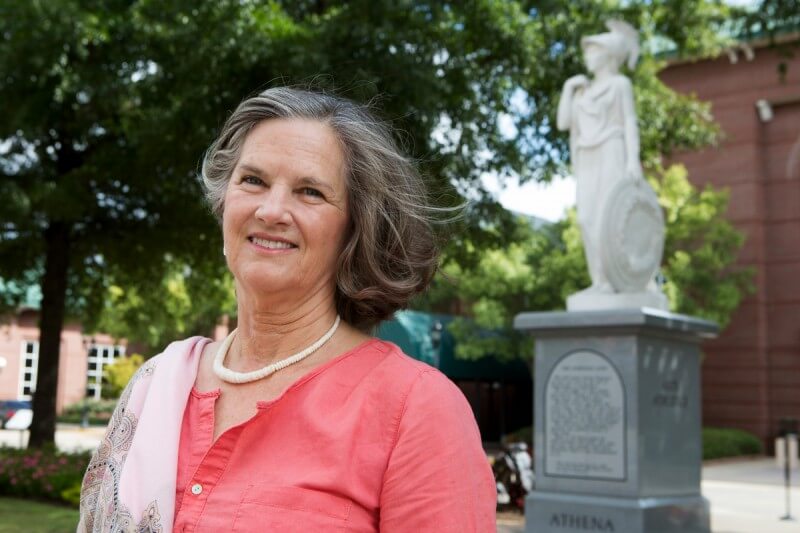 Westmacott finished the Master of Fine Arts degree in sculpture in 1973, and then began the balancing act practiced by artists as their art – rather than imitating life – collides with life. She held part-time, temporary positions teaching and waitressing while also creating her own paintings, drawings and sculpture.
Westmacott finished the Master of Fine Arts degree in sculpture in 1973, and then began the balancing act practiced by artists as their art – rather than imitating life – collides with life. She held part-time, temporary positions teaching and waitressing while also creating her own paintings, drawings and sculpture.
Once while she drove along the Pennsylvania Turnpike, her Volkswagen Beetle conked out. It needed a new engine.
“The mechanic told me he could take out the old one and pop in a new one for $300,” she said of a time when that kind of money represented about a month’s wages. “He drove me to stay overnight with friends I had in the area and picked me up the next morning and drove me back to the garage. I told him I didn’t have $300, but would send it as soon as I could. He said, ‘I don’t want your money, I want you to do a portrait of me.’”
In the late summer of 1975, she met Richard, a native of England who had earned a Ph.D. in landscape architecture at Penn. She describes their first lunch as “riotous” as they discovered a shared passion for Thomas Love Peacock, a satirist of his fellow poets in the first half of the 19th century.
Before long, Jean and Richard were taking turns traveling across the Atlantic to be together and, in the fall of 1976 they married in England. The following June, they arrived in Athens for what was supposed to be a month-long stay while Richard worked on a project at the University of Georgia.
Jean focused her energies on completing a commission and “rode around a lot,” enjoying the rural areas outside of Athens, particularly the many old houses. As the couple prepared to return to England they decided to “look and see what properties were available.” The first house they looked at was covered in kudzu; the second house became their home.
“The owner held it for us in May and June, until we could move here from England,” Westmacott recalls. “The house wasn’t livable, so we basically camped in a little shack that had one light, and bathed by swimming in the pond – that’s when we came to love Ivory soap. It floats.”
Richard accepted a faculty position at UGA and Jean spent the next 3½ years as director of the Oglethorpe County Child Development Center, a federal- and state-funded day-care center in nearby Crawford. After their son, Jesse, became too old to go to the center with Westmacott, she began spending her summers in New Jersey, near where her mother lived, teaching basic and figure sculpture for several summers at Ocean County College. She also taught figure modeling and drawing one summer for the UGA studies abroad program in Cortona, Italy, and participated in a variety of exhibitions.
HUBRIS OR CHUTZPAH?
Meanwhile, in Gainesville, the president of newly constituted Brenau University, John S. Burd, had this brilliant idea that the school needed to beef up its permanent art collection and build an art exhibition program both for student outreach and community service. After all, there was a Brenau connection with pop art icon Jasper Johns – whose 1954-55 painting, Flag, represents the million-dollar sale of a work by a living American artist. Johns’ two aunts, Gladys and Eunice, had attended Brenau College. In the oft-told tale, Burd recalls sending a note to Johns asking the aloof, sometimes abrasive artist if he would put on a show or donate a painting or something to help out Gladys and Eunice’s old school. Johns basically blew Burd off, telling him he had to talk to “my agent,” Leo Castelli.
Referring to Castelli as a mere agent is about like saying of Michelangelo after he had finished the Sistine Chapel “a pretty good house painter.” In a 2010 biography of Castelli, author Annie Cohen-Solal describes him as having “reigned for decades as America’s most influential art dealer,” and even that is understatement. Castelli established pop art as the iconic representation of American are in the mid-20th century as the United States, particularly New York, displaced the capitals in Europe as the epicenter for the modern art earthquake that shook the world. But Burd initially did not know that. Fortunately, by the time Burd got to Castelli’s New York gallery – ostensibly the Bethlehem manger of the pop art movement– Burd had been brief thoroughly as to who Castelli was. When he asked Castelli if he would help put on an art show in Gainesville, Georgia, the gallerist agreed. Burd subsequently asked Castelli to serve on the Brenau Board of Trustees, and Castelli agreed to that as well.
Another piece in the bold scheme that Burd put together was to create gallery place – and employ a professional to manage it – for all this great art that he was certain would be headed his way. Westmacott applied for the position of gallery director-curator and assistant professor of art and design at Brenau, thinking it would be a short-term experience. Gainesville is a 90-minute drive from her home and, in the beginning, the job was only part-time. Although she had plenty of experience in the teaching portion of her position, her experience curating exhibitions was limited. Burd threw her in the deep end of the pool.
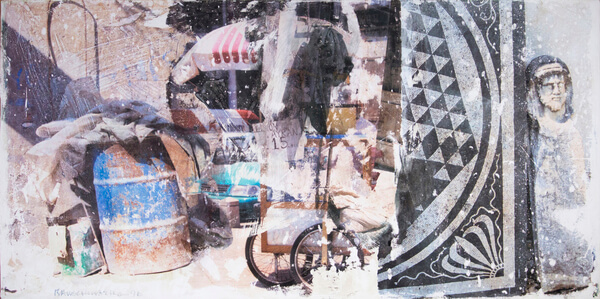
“The first exhibition I curated was 92 print pieces of Jasper Johns that came from Leo Castelli’s collection,” Westmacott recalls. The exhibition celebrated the opening of the new Simmons Visual Arts Center.
As Brenau’s art collection continued to grow and opportunities to mount new exhibitions came available, Westmacott’s position soon became full time. In addition to curating at least 10 shows annually, she also focused on establishing a museum education and outreach program for area schools.
“My role was more in working with the artists we were showing and asking them to share a piece with the college,” she said. However, she did work in a number of other ways to ensure that Brenau’s collection was highly visible. “Dr. Burd and I agreed that we didn’t want the collection warehoused. We wanted it on campus so it could be shared with the faculty, students and staff.”
That informal program started modestly by turning wall space and open areas in the library into a “living museum,” but soon expanded to making use of virtually every open space on campus so that members of the Brenau family as well as any visitor to the campus would be inundated. When Westmacott was there, every new faculty and staff member was invited to meet with her and look for a work that appealed to him or her that they could display in their offices. “There might have been a few pieces we couldn’t loan,” she said, “but basically, if we knew the person had a secure office, they had quite a large number of choices.”
(That policy still exists today. And, because the collection has continued to grow under President Ed Schrader to exceed even Burd’s wildest expectations, the university now has started turning is ancillary campuses into living galleries as well.)
Eventually, Westmacott began driving to Brenau on Mondays, working until 10 p.m., staying in a guest apartment on the campus overnight, working Tuesday, and then driving home to Oglethorpe County. She repeated the scenario on Wednesdays and Thursdays. Most Fridays, she was able to work at home. Despite the long hours, Westmacott said she loved her job.
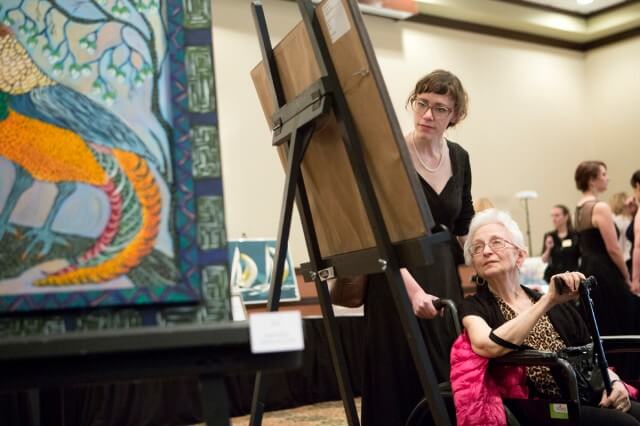
“I loved the people I worked with, I loved the students. Every day was different. It was absorbing,” she said. “Dr. Burd was very supportive and interested, but he was also hands off. As far as the gallery went, it was pretty much up to me. Dr. Burd would open the possibilities for exhibitions, but he never really pushed.”
Through the years, Westmacott curated a variety of exhibitions, many through Castelli contacts, including works by Johns’ long-time lover Robert Rauschenberg, James Rosenquist and Donald Saff. She also met a number of artists and collectors, including Herbert and Dorothy Vogel, a mail clerk and librarian who amassed a collection of nearly 5,000 pieces of mainly conceptual and minimalist art. In 1992 the Vogels transferred their entire collection to the National Gallery of Art. Soon after, Westmacott had the opportunity to meet the Vogels and in 1998, she curated “Women Artists in the Vogel Collection.” When the Vogels began disposing of the collection by donating at least 50 pieces of art to a museum in each of the 50 states, the High Museum in Atlanta became the Georgia beneficiary. The couple also they also gave pieces to two schools – Dorothy Vogel’s alma mater, Syracuse University, and this little school in Georgia, Brenau. The Vogel relationship continues today: Dorothy Vogel, who survives her husband, attended the Brenau Gala in March commemorating the opening of the new Manhattan Gallery at Brenau Downtown Center. She told one interviewer during her visit that the first show at Brenau of the works by women artists from the Vogel collection set the tone for what she and her husband believed would be a great relationship. (See the YouTube video of the Vogels’ participation in a panel discussion with Westmacott moderating about artist Lisa Bradley, whose work was part of the Brenau show, at https://youtu.be/8yyEPanZoEY)
signature work
“Jean is a superb sculptor, a fantastic artist and teacher,” said Burd. “She was highly respected by the faculty and students as well as the artists she worked with.”
Although Westmacott said that she had been professionally fulfilled with her curating and teaching career at Brenau, she had only a limited amount of time to focus on her art. During her time at Brenau, however, she did win a contract for what perhaps is her most notable work – the 1994 commission for the Athena sculpture that now sits in front of the Classic Center in Athens, Georgia.
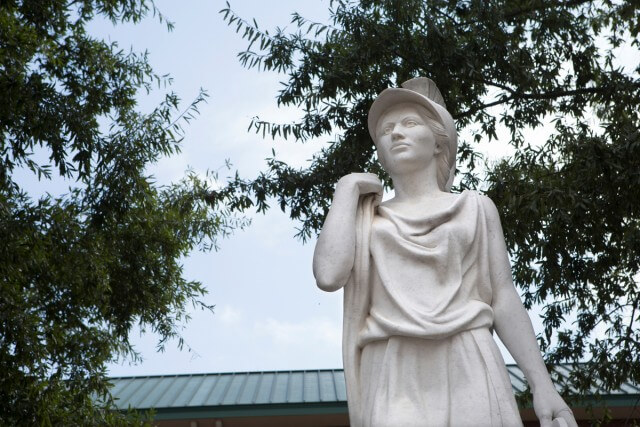
Project Athena, a group formed in 1993 to oversee installation of public art to commemorate the 1996 Olympic Games in Georgia, selected Westmacott from a number of sculptors. The Georgia city, named for the birthplace of the Olympics in ancient Greece, was the venue for several events during the ’96 summer games. In Greek mythology Athena was the goddess that represents many admirable traits, including wisdom, courage, inspiration, civilization, justice, artistry, skill, strength, and critical thinking in warfare and other aspects of life.
“I wasn’t aware of the original request for proposals for the Athena statue,” Westmacott said, “But apparently, when the committee reviewed the proposals, it was noted that no women sculptors were included. When the search reopened, a colleague at UGA suggested I apply.”
Searching for a model, Westmacott noticed what she described as the classical Greek facial structure of her part-time student assistant in the Brenau galleries, Lara Magzan, who was born in the former Yugoslavian regions just across the Adriatic Sea from Greece. Magzan became Westmacott’s Athena. ( See related article “Model Life” ).
Westmacott created her four-foot-tall Athena out of clay, drawing from an image found in the Parthenon that shows a procession that occurred every four years and included a new peplos, or cloak, being given to Athena. In her statue, Westmacott shows Athena carrying this cloak over her shoulder. In her other hand, Athena holds a shield that features an olive leaf motif, a reference to both peace and the Olympics laurel wreath.
She then shipped her clay model, half the size of what the final product was to be, to Carrera, Italy. There skilled artisans used triangulation to enlarge the measurements for the finished image, which was carved by hand in local marble.
You can see a video (MP4) about the Athena sculpture, narrated by Westmacott, at http://www.athenswelcomecenter.com/video/4-Athena_Statue.mp4.
In 2002 Westmacott completed a bust of Beulah Rucker, one of eight children born to African-American sharecroppers in Banks County, Georgia, in the late 1800s. Because schooling for black children ended at sixth grade, Rucker traveled to Athens where she milked cows and helped the principal’s wife in exchange for an opportunity to get a high school education. Rucker subsequently established a school in Gainesville that operated from the early 1900s into the 1950s. The school and Rucker’s home are now part of the Beulah Rucker Museum and Education Center where the Westmacott bronze resides.
Westmacott retired from Brenau in 2006, but continued her art. Northeast Georgia Hospital in Gainesville commissioned her 2010 bronze figure called Elpida for the hospital’s therapeutic garden. The figure features an angel with its head turned toward one of its upraised wings, perhaps in quiet meditation. The face on Elpida, also known as the Angel of Hope, is that of Westmacott’s mother, who moved from New Jersey at 95 and lived with the Westmacotts until her death.
back to brenau
Westmacott has also completed two additional bronze sculptures, commissioned by former President Burd in the early 2000s, that represent the “Brenau woman” and, “what Brenau gives to a young woman.” For a number of reasons, the work took a while. The first piece was completed and installed on the terrace outside of Simmons Visual Arts Center in 2009. The other just arrived this summer and, occupying a spot on a pedestal on the opposite side of the building’s front steps, it will be officially dedicated in the fall of 2014. Burd was on hand for the installation.
The statuary on the Brenau’s front campus purposefully celebrates Brenau women throughout the institutions 136-year history – from the Victorian era-attired women sitting primly in her ankle-length skirt on a marble bench inside the Daniel Pavilion to the Gregory Johnson piece depicting a young woman in jeans sitting in the grass with her laptop computer.
After considering the task and the other works that already are on campus, Westmacott produced one sculpture of a young woman entering Brenau and the other leaving.
“Rather than having them dressed in caps and gowns, I opted to use a shawl or scarf,” she said. “The one going in is nervous, lacking in self-confidence. She’s moving forward, but she’s looking back – maybe at her parents. She’s a little off-balance and she is pulling the shawl tightly around her.
“The one going out is walking straight forward, straight ahead. The wind is carrying her shawl behind her. She’s confident and has a sense of purpose.”
Both, however, clearly illustrate that the institution has beautifully evolved from its origins as an all-white Baptist female seminary in the segregated South. With the other pieces around the front lawn they show the cultural and racial diversity of a Brenau that is 51 percent Caucasian, 34 percent African-American and the rest a blend of Hispanic, Asian and other ethnic heritages. Although Westmacott considered using the same model for both sculptures, she ultimately decided it would be more interesting to use two different people.
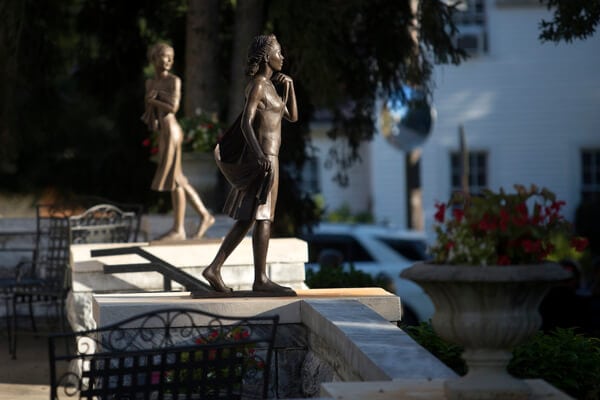 “The model for my first sculpture was Lucy Kern, who was a student in some of my classes,” said Westmacott, who completed that sculpture in 2009. “Her ethnic background includes Columbian Indian, German and Hispanic. She has beautiful bone structure, but I also liked the blend. You’re not sure of her background.”
“The model for my first sculpture was Lucy Kern, who was a student in some of my classes,” said Westmacott, who completed that sculpture in 2009. “Her ethnic background includes Columbian Indian, German and Hispanic. She has beautiful bone structure, but I also liked the blend. You’re not sure of her background.”
 The second sculpture, which was installed this fall, features Rachael “Moji” Ogunmuko, a young artist from Nigeria who has modeled for drawing courses Westmacott has been taking in recent years. “I found her to be delightful,” Westmacott said. “She has a beautiful face and huge almond-shaped eyes.”
The second sculpture, which was installed this fall, features Rachael “Moji” Ogunmuko, a young artist from Nigeria who has modeled for drawing courses Westmacott has been taking in recent years. “I found her to be delightful,” Westmacott said. “She has a beautiful face and huge almond-shaped eyes.”
As for her art, Westmacott said she’s interested in “loosening up” and creating work that’s not quite so realistic. She’s also interested in working in clay, plaster and wax, all of which are less forgiving than bronze.
“If I lose it,” she said, “I lose it.”
That, after all, is what serendipity is all about.
Denise Horton is a freelance writer living in Athens, Georgia. Additional background reporting by David Morrison
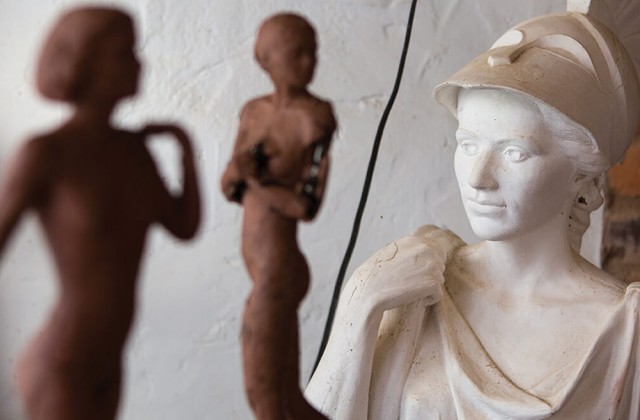

Jean Westmacott is a legacy to Brenau…being a former Temple Owl is also not a bad thing…LOL
What a wonderful story! I loved reading this and it is a honor to know this wonderful talented woman of Brenau!